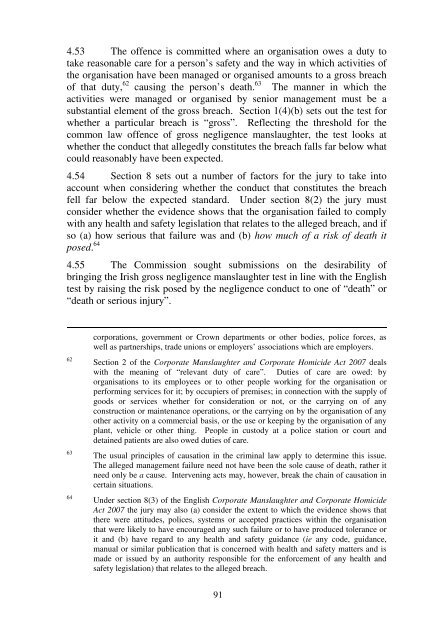murder and involuntary manslaughter - Law Reform Commission
murder and involuntary manslaughter - Law Reform Commission
murder and involuntary manslaughter - Law Reform Commission
You also want an ePaper? Increase the reach of your titles
YUMPU automatically turns print PDFs into web optimized ePapers that Google loves.
4.53 The offence is committed where an organisation owes a duty totake reasonable care for a person’s safety <strong>and</strong> the way in which activities ofthe organisation have been managed or organised amounts to a gross breachof that duty, 62 causing the person’s death. 63 The manner in which theactivities were managed or organised by senior management must be asubstantial element of the gross breach. Section 1(4)(b) sets out the test forwhether a particular breach is “gross”. Reflecting the threshold for thecommon law offence of gross negligence <strong>manslaughter</strong>, the test looks atwhether the conduct that allegedly constitutes the breach falls far below whatcould reasonably have been expected.4.54 Section 8 sets out a number of factors for the jury to take intoaccount when considering whether the conduct that constitutes the breachfell far below the expected st<strong>and</strong>ard. Under section 8(2) the jury mustconsider whether the evidence shows that the organisation failed to complywith any health <strong>and</strong> safety legislation that relates to the alleged breach, <strong>and</strong> ifso (a) how serious that failure was <strong>and</strong> (b) how much of a risk of death itposed. 644.55 The <strong>Commission</strong> sought submissions on the desirability ofbringing the Irish gross negligence <strong>manslaughter</strong> test in line with the Englishtest by raising the risk posed by the negligence conduct to one of “death” or“death or serious injury”.626364corporations, government or Crown departments or other bodies, police forces, aswell as partnerships, trade unions or employers’ associations which are employers.Section 2 of the Corporate Manslaughter <strong>and</strong> Corporate Homicide Act 2007 dealswith the meaning of “relevant duty of care”. Duties of care are owed: byorganisations to its employees or to other people working for the organisation orperforming services for it; by occupiers of premises; in connection with the supply ofgoods or services whether for consideration or not, or the carrying on of anyconstruction or maintenance operations, or the carrying on by the organisation of anyother activity on a commercial basis, or the use or keeping by the organisation of anyplant, vehicle or other thing. People in custody at a police station or court <strong>and</strong>detained patients are also owed duties of care.The usual principles of causation in the criminal law apply to determine this issue.The alleged management failure need not have been the sole cause of death, rather itneed only be a cause. Intervening acts may, however, break the chain of causation incertain situations.Under section 8(3) of the English Corporate Manslaughter <strong>and</strong> Corporate HomicideAct 2007 the jury may also (a) consider the extent to which the evidence shows thatthere were attitudes, polices, systems or accepted practices within the organisationthat were likely to have encouraged any such failure or to have produced tolerance orit <strong>and</strong> (b) have regard to any health <strong>and</strong> safety guidance (ie any code, guidance,manual or similar publication that is concerned with health <strong>and</strong> safety matters <strong>and</strong> ismade or issued by an authority responsible for the enforcement of any health <strong>and</strong>safety legislation) that relates to the alleged breach.91
















